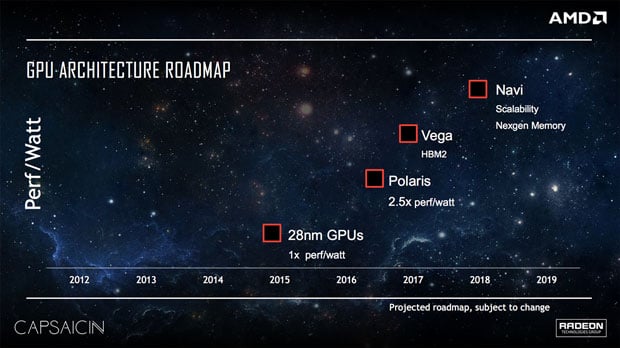AMD GPU Roadmap Shows Polaris Arrives Mid-2016 With HBM2-Equipped Vega Quickly Behind It In Early 2017
The big news yesterday from the AMD camp was with the official announcement of the Radeon Pro Duo, which was previously known as the Radeon R9 Fury X2. The water-cooled graphics card features two R9 Fury GPU cores clocked at 1GHz all operating within a 350W power envelope. But of course, we’re always looking to see what’s right around the corner, and in AMD’s case, that means Polaris.
Polaris is destined to arrive about mid-way through 2016 and will move from a 28nm to a 14nm FinFET (Global Foundries) manufacturing processes. The move to FinFET allows for a radical decrease in power consumption with a new roadmap that was shared with us yesterday.

So just how efficient is Polaris? If we use AMD’s current generation 28nm GPUs as a baseline, Polaris offers a 2.5x performance-per-watt improvement. As we’ve already revealed, Polaris is based on fourth generation GCN (Graphics Core Next) architecture, supports HDMI 2.0a and DisplayPort 1.3, and supports h.265 decoding at up to 4K (4K h.265 encoding at 60FPS). You’ll also find a Primitive Discard Accelerator, a more efficient hardware scheduler and improved memory compression.
What’s perhaps most surprising takeaway from the roadmap is that Polaris will be quickly eclipsed by Vega. Vega will arrive in early 2017 and offers up another sizable boost in performance-per-watt (both in comparison to 28nm AMD GPUs and Polaris) along with support for High Bandwidth Memory 2 (HBM2).

The rather short time span in between Polaris and Vega is both interesting, but at the same time understandable. Polaris will reportedly continue to use first generation HBM (in at least one version), which is limited to 4GB stacks. HBM2, on the other hand, tops out at 16GB. Given that the next generation NVIDIA Pascal architecture is packing HBM2, Polaris will be at disadvantage on the memory front, which could explain the quick transition to Vega.
We should also note that AMD has confirmed that there will be both Polaris 10 and Polaris 11 GPUs, with the Polaris 11 being a smaller GPU likely destined for mobile applications. Likewise, there will also be Vega 10 and Vega 11 GPUs.
Moving on to the 2018 timeframe, AMD will will introduce its Navi architecture which is only identified by its “scalability” and “next gen memory.” Given that its release is so far off, we’re going to have to wait quite a while before more details are fleshed out on this high-end GPU architecture.

